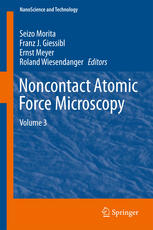

Most ebook files are in PDF format, so you can easily read them using various software such as Foxit Reader or directly on the Google Chrome browser.
Some ebook files are released by publishers in other formats such as .awz, .mobi, .epub, .fb2, etc. You may need to install specific software to read these formats on mobile/PC, such as Calibre.
Please read the tutorial at this link: https://ebookbell.com/faq
We offer FREE conversion to the popular formats you request; however, this may take some time. Therefore, right after payment, please email us, and we will try to provide the service as quickly as possible.
For some exceptional file formats or broken links (if any), please refrain from opening any disputes. Instead, email us first, and we will try to assist within a maximum of 6 hours.
EbookBell Team

4.3
58 reviewsThis book presents the latest developments in noncontact atomic force microscopy. It deals with the following outstanding functions and applications that have been obtained with atomic resolution after the publication of volume 2: (1) Pauli repulsive force imaging of molecular structure, (2) Applications of force spectroscopy and force mapping with atomic resolution, (3) Applications of tuning forks, (4) Applications of atomic/molecular manipulation, (5) Applications of magnetic exchange force microscopy, (6) Applications of atomic and molecular imaging in liquids, (7) Applications of combined AFM/STM with atomic resolution, and (8) New technologies in dynamic force microscopy. These results and technologies are now expanding the capacity of the NC-AFM with imaging functions on an atomic scale toward making them characterization and manipulation tools of individual atoms/molecules and nanostructures, with outstanding capability at the level of molecular, atomic, and subatomic resolution. Since the publication of vol. 2 of the book Noncontact Atomic Force Microscopy in 2009 the noncontact atomic force microscope, which can image even insulators with atomic resolution, has achieved remarkable progress. The NC-AFM is now becoming crucial for nanoscience and nanotechnology.